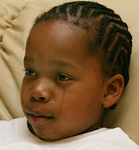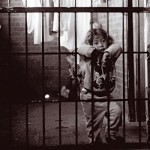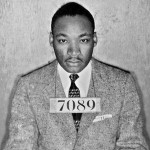Schoolhouse to Jailhouse: Children of Color Under Arrest in U.S.
The ‘School to Prison Pipeline’: Education Under Arrest
By Kanya D’Almeida
IPS
Washington — Metal detectors. Teams of drug-sniffing dogs. Armed guards and riot police. Forbiddingly high walls topped with barbed wire.
Such descriptions befit a prison or perhaps a high-security checkpoint in a war zone. But in the U.S., these scenes of surveillance and control are most visible in public schools, where in some areas, education is becoming increasingly synonymous with incarceration.
The United Nations, along with various human rights bodies and international courts, have recognised that
“free education is the cornerstone of success and social development for young people”.

Gerard Mungo Jr., who was arrested by Baltimore City police, handcuffed, fingerprinted, and photographed for a mug shot for sitting on a dirt bike on a sidewalk.
The landmark Brown v. Board of Education court ruling, which officially desegregated U.S. schools in 1954, stated,
“It is doubtful that any child may reasonably be expected to succeed in life if (he/she is) denied the opportunity of an education.”
Yet hundreds of thousands of children in the U.S. are being systematically stripped of their right to education and transferred from the schoolhouse to the jailhouse.
|
Along with tough disciplinary measures such as “zero tolerance policies,” the last two decades have seen a huge influx of law enforcement officers into playgrounds and classrooms.
Statistics from the U.S. Department of Justice (DOJ) indicate that the number of school resource officers (SROs) increased by 38 percent over the last ten years, even while reported incidents of theft and violence in schools are at their lowest since the National Center for Education Statistics first gathered comprehensive data in 1992.
A report released by the Justice Policy Institute (JPI) detailing the extent and impact of policing in public schools confirmed what education and justice experts have argued for years: increased law enforcement does not make schools safer for students or foster better learning.
In fact, the report found that police presence in schools devastates the learning environment, increases the number of arrests and referrals of youth into the juvenile “justice” system, and disrupts a child’s educational process by favouring suspension and expulsion over communal learning.
“Police in schools undermine the education of thousands of students each year,”
Amanda Petteruti, lead author of JPI’s report, told IPS.
“The impact of arresting and incarcerating students is significant: research has shown that within a year of reenrolling after spending time confined, two-thirds to three- fourths of formerly incarcerated youth withdraw or drop out of school. After four years, less than 15 percent of these youth had completed secondary education,” she stressed.
“Even contact with courts increases the chances that a high school student will drop out,” she added.
Children under siege
According to ‘Derailed! The Schoolhouse to Jailhouse Track’, a detailed study undertaken by the Advancement Project, a six year-old student in Palm Beach County, Florida was arrested back in 2003 for
‘trespassing on school property’,
while walking through the schoolyard on his way home.
In Indianola, Mississippi, elementary school students have been hauled off to jail for talking during an assembly.
Two elementary school kids from Irvington, New Jersey were charged with ‘terroristic threatening’ for playing cops and robbers – with a paper plane.
In 2007, school security cameras captured footage of two guards in Palmdale, California assaulting a 16-year-old girl and breaking her arm for dropping a piece of cake on the floor. Both armed guards pushed the high-school student down on a table, throwing racial slurs like “nappy-head” at her while twisting her arm.
These stories, unfortunately, are not exceptional, but have become the norm in hundreds of public schools across the country. Most of the thousands of arrests and referrals that happen each year are for minor infractions, misdemeanors or perceived ‘threats’ such as those outlined above, based on the subjective opinions of teachers or security guards.
Students of color often bear the brunt of these punitive policies.
“Data from (think tanks) suggest that students of color are disproportionately affected by the presence of SROs,” Petteruti told IPS, particularly
“in districts like Pinellas County, Florida, South Carolina, Colorado and, according to the ACLU in Connecticut, East Hartford”.
The Advancement Project also found that it was 58 percent more likely for police to be called into schools whose student body was majority black, Latino, Native American or Asian American.
“Data from the U.S. Department of Education (DOE) indicates that students of color are more likely to be suspended than white students, and are more likely to go to schools where there are more law enforcement responses. Students of color are more also more likely to come into contact with police and surveillance in schools,” Petteruti said.
The severe policing of urban schools in low-income neighborhoods and communities of color is an extension of a nationwide racially biased strategy that hounds minorities and swallows them up in burgeoning prisons. The strategy has roots in the ‘get tough on crime’ movements of the 1980s and early 1990s.
According to the Advancement Project,
“the media and political world focused on a growing crime problem and a few brutal crimes to create a new type of criminal, the ‘superpredator’.
“Superpredators were brutal, conscienceless, incorrigible and, most frighteningly, they were young. They were presented as the products of permissive single-parent families, poverty and a lenient judicial system,” it continued.”
The public and political system responded with outrage and with draconian changes to juvenile law – boot camps, and a zero tolerance attitude that made even the slightest offence a crime.
Download PDF of Justice Policy Institute Full Report.
Download PDF of Advancement Project Full Report.
Source: IPS






Comments
Schoolhouse to Jailhouse: Children of Color Under Arrest in U.S. — No Comments